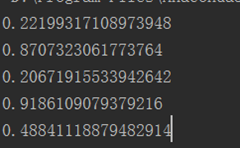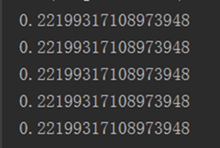numpy之random学习
2018-01-31 11:35
417 查看
在机器学习中参数初始化需要进行随机生成,同时样本也需要随机生成,或者遵从一定规则随机生成,所以对随机生成的使用显得格外重要。
有的是生成随机数,有的是随机序列,有点是从随机序列中选择元素等等。
rand函数根据给定维度生成[0,1)之间的数据,包含0,不包含1
dn表格每个维度
返回值为指定维度的array
dtype=’l’)
返回随机整数,范围区间为[low,high),包含low,不包含high
参数:low为最小值,high为最大值,size为数组维度大小,dtype为数据类型,默认的数据类型是np.int
high没有填写时,默认生成随机数的范围是[0,low)
numpy.random.randn(d0,d1,…,dn)
randn函数返回一个或一组样本,具有标准正态分布。
dn表格每个维度
返回值为指定维度的array
标准正态分布介绍
标准正态分布—-standard normal distribution
标准正态分布又称为u分布,是以0为均值、以1为标准差的正态分布,记为N(0,1)。
4、choice(),这个函数经常使用,经常在从序列中随机选择元素,而且还是指定选择出元素序列,很是方便。关键是可以为每个元素制定选择的概率。即p
numpy.random.choice(a, size=None, replace=True,
p=None)
从给定的一维数组中生成随机数
参数:
a为一维数组类似数据或整数;size为数组维度;p为数组中的数据出现的概率
a为整数时,对应的一维数组为np.arange(a)
参数p的长度与参数a的长度需要一致;
参数p为概率,p里的数据之和应为1
a=random.sample(lists,3)
print (a)
[8, 6, 10]
上面两者都收用于打乱数组的排序,功能是一样的。
numpy.random.permutation(x):与numpy.random.shuffle(x)函数功能相同,两者区别:peumutation(x)不会修改X的顺序。
因为前者返回了一个副本。
1. 函数原型: numpy.random.uniform(low,high,size)
功能:从一个均匀分布[low,high)中随机采样,注意定义域是左闭右开,即包含low,不包含high.
参数介绍:
low: 采样下界,float类型,默认值为0;
high: 采样上界,float类型,默认值为1;
size: 输出样本数目,为int或元组(tuple)类型,例如,size=(m,n,k), 则输出m*n*k个样本,缺省时输出1个值。2. 类似uniform,还有以下随机数产生函数:
a. randint: 原型:numpy.random.randint(low, high=None, size=None, dtype='l'),产生随机整数;
b. random_integers: 原型: numpy.random.random_integers(low, high=None, size=None),在闭区间上产生随机整数;
c. random_sample: 原型: numpy.random.random_sample(size=None),在[0.0,1.0)上随机采样;
d. random: 原型: numpy.random.random(size=None),和random_sample一样,是random_sample的别名;
e. rand: 原型: numpy.random.rand(d0, d1, ..., dn),产生d0 - d1 - ... - dn形状的在[0,1)上均匀分布的float型数。
f. randn: 原型:numpy.random.randn(d0,d1,...,dn),产生d0 - d1 - ... - dn形状的标准正态分布的float型数

在分布中标准正态分布和正态分布很重要,因为分布状态类似高斯分布,这个在数据样本产生中经常使用。normal和standnormal,但是这些可以通过randn生成。
[align=left]
[/align][align=left]numpy.random.seed()是个很有意思的方法,它可以使多次生成的随机数相同。[/align][align=left]如果在seed()中传入的数字相同,那么接下来使用random()或者rand()方法所生成的随机数序列都是相同的(仅限使用一次random()或者rand()方法,第二次以及更多次仍然是随机的数字),知道改变传入seed()的值,以后再改回来,random()生成的随机数序列仍然与之前所产生的序列相同[/align]

[align=left]如果这样设置,则seed只起到第一次作用,后续随机数则同。如果代码为:[/align]

[align=left]这样则随机数产生的是相同的,所以如果想生成相同的随机数,必须在生成前布下种子。[/align]
2、Numpy之random学习
有的是生成随机数,有的是随机序列,有点是从随机序列中选择元素等等。
简单的随机数据
| rand(d0, d1, ..., dn) | 随机值>>> np.random.rand(3,2) array([[ 0.14022471, 0.96360618], #random [ 0.37601032, 0.25528411], #random [ 0.49313049, 0.94909878]]) #random |
| randn(d0, d1, ..., dn) | 返回一个样本,具有标准正态分布。 Notes For random samples from  , use: sigma * np.random.randn(...) + mu Examples >>> np.random.randn() 2.1923875335537315 #random Two-by-four array of samples from N(3, 6.25): >>> 2.5 * np.random.randn(2, 4) + 3 array([[-4.49401501, 4.00950034, -1.81814867, 7.29718677], #random [ 0.39924804, 4.68456316, 4.99394529, 4.84057254]]) #random |
| randint(low[, high, size]) | 返回随机的整数,位于半开区间 [low, high)。 >>> np.random.randint(2, size=10) array([1, 0, 0, 0, 1, 1, 0, 0, 1, 0]) >>> np.random.randint(1, size=10) array([0, 0, 0, 0, 0, 0, 0, 0, 0, 0]) Generate a 2 x 4 array of ints between 0 and 4, inclusive: >>> np.random.randint(5, size=(2, 4)) array([[4, 0, 2, 1], [3, 2, 2, 0]]) |
| random_integers(low[, high, size]) | 返回随机的整数,位于闭区间 [low, high]。 Notes To sample from N evenly spaced floating-point numbers between a and b, use: a + (b - a) * (np.random.random_integers(N) - 1) / (N - 1.) Examples >>> np.random.random_integers(5) 4 >>> type(np.random.random_integers(5)) <type ‘int‘> >>> np.random.random_integers(5, size=(3.,2.)) array([[5, 4], [3, 3], [4, 5]]) Choose five random numbers from the set of five evenly-spaced numbers between 0 and 2.5, inclusive (i.e., from the set  ): >>> 2.5 * (np.random.random_integers(5, size=(5,)) - 1) / 4. array([ 0.625, 1.25 , 0.625, 0.625, 2.5 ]) Roll two six sided dice 1000 times and sum the results: >>> d1 = np.random.random_integers(1, 6, 1000) >>> d2 = np.random.random_integers(1, 6, 1000) >>> dsums = d1 + d2 Display results as a histogram: >>> import matplotlib.pyplot as plt >>> count, bins, ignored = plt.hist(dsums, 11, normed=True) >>> plt.show() |
| random_sample([size]) | 返回随机的浮点数,在半开区间 [0.0, 1.0)。 To sample  multiply the output ofrandom_sample by (b-a) and add a: (b - a) * random_sample() + a Examples >>> np.random.random_sample() 0.47108547995356098 >>> type(np.random.random_sample()) <type ‘float‘> >>> np.random.random_sample((5,)) array([ 0.30220482, 0.86820401, 0.1654503 , 0.11659149, 0.54323428]) Three-by-two array of random numbers from [-5, 0): >>> 5 * np.random.random_sample((3, 2)) - 5 array([[-3.99149989, -0.52338984], [-2.99091858, -0.79479508], [-1.23204345, -1.75224494]]) |
| random([size]) | 返回随机的浮点数,在半开区间 [0.0, 1.0)。 (官网例子与random_sample完全一样) |
| ranf([size]) | 返回随机的浮点数,在半开区间 [0.0, 1.0)。 (官网例子与random_sample完全一样) |
| sample([size]) | 返回随机的浮点数,在半开区间 [0.0, 1.0)。 (官网例子与random_sample完全一样) |
| choice(a[, size, replace, p]) | 生成一个随机样本,从一个给定的一维数组 Examples Generate a uniform random sample from np.arange(5) of size 3: >>> np.random.choice(5, 3) array([0, 3, 4]) >>> #This is equivalent to np.random.randint(0,5,3) Generate a non-uniform random sample from np.arange(5) of size 3: >>> np.random.choice(5, 3, p=[0.1, 0, 0.3, 0.6, 0]) array([3, 3, 0]) Generate a uniform random sample from np.arange(5) of size 3 without replacement: >>> np.random.choice(5, 3, replace=False) array([3,1,0]) >>> #This is equivalent to np.random.permutation(np.arange(5))[:3] Generate a non-uniform random sample from np.arange(5) of size 3 without replacement: >>> np.random.choice(5, 3, replace=False, p=[0.1, 0, 0.3, 0.6, 0]) array([2, 3, 0]) Any of the above can be repeated with an arbitrary array-like instead of just integers. For instance: >>> aa_milne_arr = [‘pooh‘, ‘rabbit‘, ‘piglet‘, ‘Christopher‘] >>> np.random.choice(aa_milne_arr, 5, p=[0.5, 0.1, 0.1, 0.3]) array([‘pooh‘, ‘pooh‘, ‘pooh‘, ‘Christopher‘, ‘piglet‘], dtype=‘|S11‘) |
| bytes(length) | 返回随机字节。>>> np.random.bytes(10) ‘ eh\x85\x022SZ\xbf\xa4‘ #random |
产生随机数的方式很多种,应用比较广的是
1、rand()、random产生随机的浮点数,但基本在0-1区间内,添加一个参数标注随机序列的size,这个函数的用法和random的一致,两者区别就是一个可以生成二维序列,一个不行。
numpy.random.rand(d0,d1,…,dn)rand函数根据给定维度生成[0,1)之间的数据,包含0,不包含1
dn表格每个维度
返回值为指定维度的array
np.random.rand(4,2)
array([[ 0.02173903, 0.44376568], [ 0.25309942, 0.85259262], [ 0.56465709, 0.95135013], [ 0.14145746, 0.55389458]])
np.random.rand(4,3,2) # shape: 4*3*2
array([[[ 0.08256277, 0.11408276], [ 0.11182496, 0.51452019], [ 0.09731856, 0.18279204]], [[ 0.74637005, 0.76065562], [ 0.32060311, 0.69410458], [ 0.28890543, 0.68532579]], [[ 0.72110169, 0.52517524], [ 0.32876607, 0.66632414], [ 0.45762399, 0.49176764]], [[ 0.73886671, 0.81877121], [ 0.03984658, 0.99454548], [ 0.18205926, 0.99637823]]])
2、randint(),产生随机整数,特点是可以指定最大值和最小值,返回的是整数。当然也可以指定size,size中每个数都在low和high内。
numpy.random.randint(low, high=None, size=None,dtype=’l’)
返回随机整数,范围区间为[low,high),包含low,不包含high
参数:low为最小值,high为最大值,size为数组维度大小,dtype为数据类型,默认的数据类型是np.int
high没有填写时,默认生成随机数的范围是[0,low)
np.random.randint(1,size=5) # 返回[0,1)之间的整数,所以只有0
array([0, 0, 0, 0, 0])
np.random.randint(1,5) # 返回1个[1,5)时间的随机整数
4
np.random.randint(-5,5,size=(2,2))
array([[ 2, -1], [ 2, 0]])3、randn(),其中n表示标准正态分布,这个在生成样本的时候经常使用,需要指定这个序列的尺寸
numpy.random.randn(d0,d1,…,dn)
randn函数返回一个或一组样本,具有标准正态分布。
dn表格每个维度
返回值为指定维度的array
np.random.randn() # 当没有参数时,返回单个数据
-1.1241580894939212
np.random.randn(2,4)
array([[ 0.27795239, -2.57882503, 0.3817649 , 1.42367345], [-1.16724625, -0.22408299, 0.63006614, -0.41714538]])
np.random.randn(4,3,2)
array([[[ 1.27820764, 0.92479163], [-0.15151257, 1.3428253 ], [-1.30948998, 0.15493686]], [[-1.49645411, -0.27724089], [ 0.71590275, 0.81377671], [-0.71833341, 1.61637676]], [[ 0.52486563, -1.7345101 ], [ 1.24456943, -0.10902915], [ 1.27292735, -0.00926068]], [[ 0.88303 , 0.46116413], [ 0.13305507, 2.44968809], [-0.73132153, -0.88586716]]])
标准正态分布介绍
标准正态分布—-standard normal distribution
标准正态分布又称为u分布,是以0为均值、以1为标准差的正态分布,记为N(0,1)。
4、choice(),这个函数经常使用,经常在从序列中随机选择元素,而且还是指定选择出元素序列,很是方便。关键是可以为每个元素制定选择的概率。即p
numpy.random.choice(a, size=None, replace=True,
p=None)
从给定的一维数组中生成随机数
参数:
a为一维数组类似数据或整数;size为数组维度;p为数组中的数据出现的概率
a为整数时,对应的一维数组为np.arange(a)
np.random.choice(5,3)
array([4, 1, 4])
np.random.choice(5, 3, replace=False) # 当replace为False时,生成的随机数不能有重复的数值
array([0, 3, 1])
np.random.choice(5,size=(3,2))
array([[1, 0], [4, 2], [3, 3]])
demo_list = ['lenovo', 'sansumg','moto','xiaomi', 'iphone'] np.random.choice(demo_list,size=(3,3))
array([['moto', 'iphone', 'xiaomi'], ['lenovo', 'xiaomi', 'xiaomi'], ['xiaomi', 'lenovo', 'iphone']], dtype='<U7')
参数p的长度与参数a的长度需要一致;
参数p为概率,p里的数据之和应为1
demo_list = ['lenovo', 'sansumg','moto','xiaomi', 'iphone'] np.random.choice(demo_list,size=(3,3), p=[0.1,0.6,0.1,0.1,0.1])
array([['sansumg', 'sansumg', 'sansumg'], ['sansumg', 'sansumg', 'sansumg'], ['sansumg', 'xiaomi', 'iphone']], dtype='<U7')
5、sample
lists=[1,2,3,4,5,6,7,8,10] #从指定序列中随机获取指定长度的片断a=random.sample(lists,3)
print (a)
[8, 6, 10]
排列
| shuffle(x) | 现场修改序列,改变自身内容。(类似洗牌,打乱顺序)>>> arr = np.arange(10) >>> np.random.shuffle(arr) >>> arr [1 7 5 2 9 4 3 6 0 8] This function only shuffles the array along the first index of a multi-dimensional array: >>> arr = np.arange(9).reshape((3, 3)) >>> np.random.shuffle(arr) >>> arr array([[3, 4, 5], [6, 7, 8], [0, 1, 2]]) |
| permutation(x) | 返回一个随机排列>>> np.random.permutation(10) array([1, 7, 4, 3, 0, 9, 2, 5, 8, 6]) >>> np.random.permutation([1, 4, 9, 12, 15]) array([15, 1, 9, 4, 12]) >>> arr = np.arange(9).reshape((3, 3)) >>> np.random.permutation(arr) array([[6, 7, 8], [0, 1, 2], [3, 4, 5]]) |
numpy.random.permutation(x):与numpy.random.shuffle(x)函数功能相同,两者区别:peumutation(x)不会修改X的顺序。
因为前者返回了一个副本。
分布
| beta(a, b[, size]) | 贝塔分布样本,在 [0, 1]内。 |
| binomial(n, p[, size]) | 二项分布的样本。 |
| chisquare(df[, size]) | 卡方分布样本。 |
| dirichlet(alpha[, size]) | 狄利克雷分布样本。 |
| exponential([scale, size]) | 指数分布 |
| f(dfnum, dfden[, size]) | F分布样本。 |
| gamma(shape[, scale, size]) | 伽马分布 |
| geometric(p[, size]) | 几何分布 |
| gumbel([loc, scale, size]) | 耿贝尔分布。 |
| hypergeometric(ngood, nbad, nsample[, size]) | 超几何分布样本。 |
| laplace([loc, scale, size]) | 拉普拉斯或双指数分布样本 |
| logistic([loc, scale, size]) | Logistic分布样本 |
| lognormal([mean, sigma, size]) | 对数正态分布 |
| logseries(p[, size]) | 对数级数分布。 |
| multinomial(n, pvals[, size]) | 多项分布 |
| multivariate_normal(mean, cov[, size]) | 多元正态分布。>>> mean = [0,0] >>> cov = [[1,0],[0,100]] # diagonal covariance, points lie on x or y-axis >>> import matplotlib.pyplot as plt >>> x, y = np.random.multivariate_normal(mean, cov, 5000).T >>> plt.plot(x, y, ‘x‘); plt.axis(‘equal‘); plt.show() |
| negative_binomial(n, p[, size]) | 负二项分布 |
| noncentral_chisquare(df, nonc[, size]) | 非中心卡方分布 |
| noncentral_f(dfnum, dfden, nonc[, size]) | 非中心F分布 |
| normal([loc, scale, size]) | 正态(高斯)分布 Notes The probability density for the Gaussian distribution is  where  is the mean and  the standard deviation. The square of the standard deviation,  , is called the variance. The function has its peak at the mean, and its “spread” increases with the standard deviation (the function reaches 0.607 times its maximum at  and  [R217]). Examples Draw samples from the distribution: >>> mu, sigma = 0, 0.1 # mean and standard deviation >>> s = np.random.normal(mu, sigma, 1000) Verify the mean and the variance: >>> abs(mu - np.mean(s)) < 0.01 True >>> abs(sigma - np.std(s, ddof=1)) < 0.01 True Display the histogram of the samples, along with the probability density function: >>> import matplotlib.pyplot as plt >>> count, bins, ignored = plt.hist(s, 30, normed=True) >>> plt.plot(bins, 1/(sigma * np.sqrt(2 * np.pi)) * ... np.exp( - (bins - mu)**2 / (2 * sigma**2) ), ... linewidth=2, color=‘r‘) >>> plt.show() |
| pareto(a[, size]) | 帕累托(Lomax)分布 |
| poisson([lam, size]) | 泊松分布 |
| power(a[, size]) | Draws samples in [0, 1] from a power distribution with positive exponent a - 1. |
| rayleigh([scale, size]) | Rayleigh 分布 |
| standard_cauchy([size]) | 标准柯西分布 |
| standard_exponential([size]) | 标准的指数分布 |
| standard_gamma(shape[, size]) | 标准伽马分布 |
| standard_normal([size]) | 标准正态分布 (mean=0, stdev=1). |
| standard_t(df[, size]) | Standard Student’s t distribution with df degrees of freedom. |
| triangular(left, mode, right[, size]) | 三角形分布 |
| uniform([low, high, size]) | 均匀分布 |
| vonmises(mu, kappa[, size]) | von Mises分布 |
| wald(mean, scale[, size]) | 瓦尔德(逆高斯)分布 |
| weibull(a[, size]) | Weibull 分布 |
| zipf(a[, size]) | 齐普夫分布 |
random的的分布,其实就是随机生成器的完善版,比如:
numpy.random.uniform介绍:1. 函数原型: numpy.random.uniform(low,high,size)
功能:从一个均匀分布[low,high)中随机采样,注意定义域是左闭右开,即包含low,不包含high.
参数介绍:
low: 采样下界,float类型,默认值为0;
high: 采样上界,float类型,默认值为1;
size: 输出样本数目,为int或元组(tuple)类型,例如,size=(m,n,k), 则输出m*n*k个样本,缺省时输出1个值。2. 类似uniform,还有以下随机数产生函数:
a. randint: 原型:numpy.random.randint(low, high=None, size=None, dtype='l'),产生随机整数;
b. random_integers: 原型: numpy.random.random_integers(low, high=None, size=None),在闭区间上产生随机整数;
c. random_sample: 原型: numpy.random.random_sample(size=None),在[0.0,1.0)上随机采样;
d. random: 原型: numpy.random.random(size=None),和random_sample一样,是random_sample的别名;
e. rand: 原型: numpy.random.rand(d0, d1, ..., dn),产生d0 - d1 - ... - dn形状的在[0,1)上均匀分布的float型数。
f. randn: 原型:numpy.random.randn(d0,d1,...,dn),产生d0 - d1 - ... - dn形状的标准正态分布的float型数
# -*- coding: utf-8 -*- import matplotlib.pyplot as plt import numpy as np s = np.random.uniform(0,1,1200) # 产生1200个[0,1)的数 count, bins, ignored = plt.hist(s, 12, normed=True) """ hist原型: matplotlib.pyplot.hist(x, bins=10, range=None, normed=False, weights=None, cumulative=False, bottom=None, histtype='bar', align='mid', orientation='vertical',rwidth=None, log=False, color=None, label=None, stacked=False, hold=None,data=None,**kwargs) 输入参数很多,具体查看matplotlib.org,本例中用到3个参数,分别表示:s数据源,bins=12表示bin 的个数,即画多少条条状图,normed表示是否归一化,每条条状图y坐标为n/(len(x)`dbin),整个条状图积分值为1 输出:count表示数组,长度为bins,里面保存的是每个条状图的纵坐标值 bins:数组,长度为bins+1,里面保存的是所有条状图的横坐标,即边缘位置 ignored: patches,即附加参数,列表或列表的列表,本例中没有用到。 """ plt.plot(bins, np.ones_like(bins), linewidth=2, color='r') plt.show()

在分布中标准正态分布和正态分布很重要,因为分布状态类似高斯分布,这个在数据样本产生中经常使用。normal和standnormal,但是这些可以通过randn生成。
随机数生成器
| RandomState | Container for the Mersenne Twister pseudo-random number generator. |
| seed([seed]) | Seed the generator. |
| get_state() | Return a tuple representing the internal state of the generator. |
| set_state(state) | Set the internal state of the generator from a tuple. |
[/align][align=left]numpy.random.seed()是个很有意思的方法,它可以使多次生成的随机数相同。[/align][align=left]如果在seed()中传入的数字相同,那么接下来使用random()或者rand()方法所生成的随机数序列都是相同的(仅限使用一次random()或者rand()方法,第二次以及更多次仍然是随机的数字),知道改变传入seed()的值,以后再改回来,random()生成的随机数序列仍然与之前所产生的序列相同[/align]
import numpy as np np.random.seed(5) for i in range(5): print(np.random.random())

[align=left]如果这样设置,则seed只起到第一次作用,后续随机数则同。如果代码为:[/align]
import numpy as np for i in range(5): np.random.seed(5) print(np.random.random())

[align=left]这样则随机数产生的是相同的,所以如果想生成相同的随机数,必须在生成前布下种子。[/align]
参考文献
1、为什么你用不好Numpy的random函数?2、Numpy之random学习
相关文章推荐
- Numpy之random学习
- NumPy学习笔记 (3)
- python标准库学习5-random
- RNN学习第二讲-通过Python,numpy 和 theano实现一个RNN网络
- python学习--numpy的数组
- 给深度学习入门者的Python快速教程 - Numpy和Matplotlib篇
- Numpy入门学习之(五)数组、矩阵中级操作
- numpy等差数列生成函数arange学习小结
- python numpy 学习一
- Vensim学习之Random Normal函数的使用
- python学习——numpy
- Numpy学习——数组填充np.pad()函数的应用
- Java学习总结(8)—内存流,打印流,对象流,RandomAccessFile,装饰者设计模式
- 【学习笔记】WEEK2_Python and Vectorization_A note on python/numpy vectors
- Spring Boot 学习笔记 2 : Random
- python学习[4]_利用numpy做一些距离的计算
- python numpy学习
- 为什么你用不好Numpy的random函数?
- numpy.random.uniform(记住文档网址)
- Python数据挖掘学习02--numpy和pandas模块基本使用
